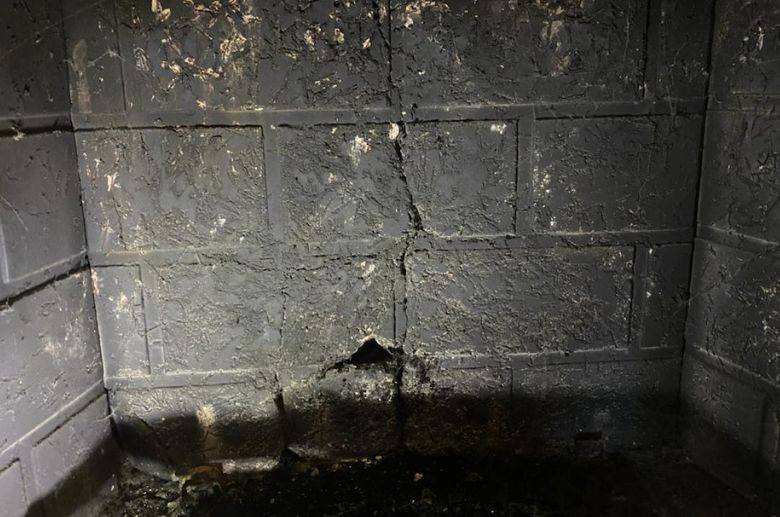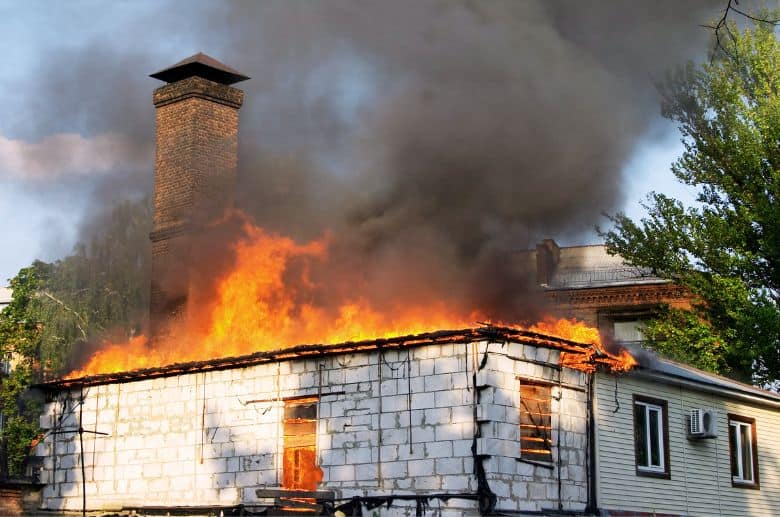A chimney is a vital part of your home, and it removes dangerous fumes and gasses like carbon monoxide when using your fireplace. It would be best to clean your chimney regularly to ensure your fireplace functions well.
If you don’t clean your chimney, creosote will accumulate, making it difficult for your chimney to remove byproducts of combustion, like toxic gasses and fumes. It could also lead to fatal chimney fires.
You can avoid this problem by regularly sweeping your chimney. In this post, we will discuss what happens if you don’t clean your chimney. Keep reading to discover more.
How Often Should a Chimney Be Cleaned?

According to the National Fire Protection Association (NFPA) guidelines, you should clean your chimney annually. Many homeowners do not adhere to this and only remember they need to clean their chimneys when it’s too late.
They end up forking out thousands of dollars on extensive repairs. When you neglect your chimney, combustion byproducts like creosote and soot will accumulate.
These substances can block the chimney, making it difficult to exhaust smoke and dangerous gasses. The smoke and fumes can enter your home and cause health issues like dizziness and eye irritation.
Remember to clean your chimney regularly, even when not using it. This is because it is integral to your home’s ventilation system.
Also, animals like raccoons, birds and squirrels can reside in the chimney and cause blockage and damage. For this reason, annual chimney inspection and cleaning by a professional are necessary.
Why is It Important to Clean Your Chimney?
It is good practice to clean your chimney regularly because it helps you avoid numerous problems.
A chimney’s purpose is to get rid of combustion byproducts like smoke and toxic gasses like carbon monoxide.
When you neglect your chimney, creosote will accumulate in the flue, making it difficult to exhaust the smoke and fumes. These fumes will enter your home and cause respiratory problems.
Moreover, creosote is highly flammable and can ignite, causing chimney fires that burn at extreme temperatures. These fires often damage the chimney liner and roof, potentially escalating into a full-blown house fire.
——
Do You Need to Hire Chimney & Fireplace Expert?
Get free quotes from qualified experts near you. No commitment required!
——
What Happens If You Don’t Clean Your Chimney?
If your chimney is dirty, you will have to face numerous issues. Let’s take a look at each in detail.
Creosote Buildup

Creosote buildup is one of the most obvious signs of a dirty chimney. Creosote is the black or dark brown tar-like substance accumulating in the chimney.
Creosote is a byproduct of the incomplete combustion of wood. Creosote is usually carried by smoke and attaches to the inside walls of the chimney.
One of the leading causes of creosote formation is wet wood. Unseasoned wood usually has a lot of moisture which prevents complete combustion.
Slow-burning wood is another reason. When the wood you are using burns slowly, it takes longer for the smoke to escape the chimney, meaning more creosote will stick to the chimney walls.
There are three stages of creosote formation:
Stage 1 – Creosote deposits look like flakes. You can easily remove the creosote using a hard brush. If you don’t get rid of it, stage 2 creosote will form.
Stage 2 – In this stage, the creosote starts to resemble tar. You can still remove it, but the process will be more challenging. It is advisable to contact a qualified chimney sweep to help you out.
Stage 3 – Here, the creosote is more concentrated and blocks airflow in the chimney. This means the smoke and fumes from the chimney will enter your house, putting you and your loved one’s health at risk. Stage 3 creosote is also likely to cause chimney and house fires and is difficult to remove. When creosote is in stage 3, we recommend hiring a certified chimney sweep to help you remove it.
Where does creosote most build up?
Creosote usually builds up in the flue liner as smoke escapes through the chimney and can also build up in the fireplace area. Scraping the inside walls of your chimney will help you determine if there is creosote buildup.
You will need a dust mask, rubber gloves, and fireplace poker. Next, scrape the inside walls. If the creosote looks flaky, it’s in its first stage, and you can easily remove it using a stiff brush.
And if the creosote is over a quarter of an inch deep, it’s at an advanced stage and will require a professional to remove it. A flashlight can help you see the extent of the creosote accumulation.
Carbon Monoxide Poisoning
Carbon monoxide is one of the gasses produced when wood is burning. Too much creosote in your chimney will make it difficult for smoke and toxic gasses like carbon monoxide to escape.
The smoke will find an alternative way through your home, and you and your loved ones will be exposed to carbon monoxide.
This toxic gas causes health issues like shortness of breath, blurred vision, headaches, dizziness, and sometimes death. Remember, carbon monoxide is odorless and colorless, so you may not know if it is entering your house.
You can purchase a carbon monoxide detector to alert you when your home has high gas levels.
Chimney Fire
Creosote is a highly flammable substance. If it accumulates in your chimney, a chimney fire will occur sooner or later. This is because chimney fires are typically hard to detect during the early stages.
Chimney fires usually get extremely hot and reach over 1000 degrees Celsius and 1832 Fahrenheit. These fires can destroy the chimney lining, costing you hundreds of dollars in repairs.
The fire can also ignite combustibles near the chimney and cause a lot of damage. Note that chimney fires usually produce cracking or popping sounds.

Health problems
Exposure to high levels of creosote can cause health problems such as skin and eye irritation.
It is always recommended to wear protective gear such as masks and gloves when removing the creosote.
Difficulty starting a fire
Airflow is restricted when too much creosote is inside your chimney’s inner walls, making it difficult for oxygen to get into the fire. Thus, starting and maintaining a fire will be a challenge.
How Do You Know If Your Chimney Needs to be Cleaned?
Here are some common signs to look out for:
- The fireplace will produce a distinct smoky odor if your chimney has creosote deposits. When you notice this smell, start preparing to clean your chimney.
- The presence of animal nests in your chimney. Birds typically build their nests at the very top of the chimney so it will be easy to notice. Squirrels are also known to nest in chimneys. Flapping, clawing, rustling and scratching noises are major indications of animals living in your chimney.
- Smoke does not rise up your chimney. This is usually due to the layers of creosote accumulating in the flue for several years.
- Creosote dripping into the firebox. If you don’t clean your chimney regularly, you will face problems such as chimney fires.
We recommend having your chimney inspected and thoroughly cleaned by a professional at least once a year. The best time of the year to clean your chimney is in fall, just before the cold season hits.
Can I Clean My Chimney By Myself?
You can clean a chimney yourself if you have the right tools and follow the right procedures. There are two popular DIY methods you can use to clean your chimney:
- Using sweeping logs – Creosote sweeping logs contain chemicals that react with creosote, reducing the buildup in your chimney. Unfortunately, sweeping logs typically remove only stage one creosote. It is ineffective at removing creosote accumulated over several months or years.
- Using a hard bristle brush to remove substances such as soot and creosote. You will need gear like a flashlight, dust mask and safety goggles when using this method.
Remember, these aren’t the best ways to clean your chimney. You will need a professional to do thorough chimney cleaning.
——
Do You Need to Hire Chimney & Fireplace Expert?
Get free quotes from qualified experts near you. No commitment required!
——
Why Hiring a chimney sweep is important
Keep in mind that cleaning a chimney yourself is usually risky. When removing creosote, exposure can cause issues like skin irritation. So, you will need to wear protective gear like masks and gloves.
When cleaning the top of the chimney, you will require equipment like a safety harness to prevent falls.
If you don’t have experience cleaning the top of your chimney, the chances of falling and getting lifelong injuries are high. Also, since you aren’t a professional, you will be unable to remove all the dirt from your chimney.
We recommend hiring a chimney sweep to clean your chimney once every year.
Another advantage of hiring a chimney sweep is that they will inspect your chimney to ensure all components are in excellent condition.
Final Thoughts
If you want your chimney to continue functioning well for many years, you need to clean it regularly. Neglecting your chimney will cause issues such as chimney fires and carbon monoxide poisoning. A certified chimney sweep will thoroughly clean your dirty chimney and fix any damaged components. You will be sure that your chimney will be dirt-free and your home and family will be safe.






